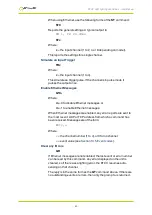
RTCC LED lighting controllers - User Manual
GardasoftMaint allows you to view the controllers on your network, change
their IP addresses and upgrade their firmware if it becomes necessary. In
the messaging section of GardasoftMaint, you can communicate with your
controller using the commands explained in
. You can also open the selected controller's web pages at
the click of a button. For more information about the RTCC's web pages,
see
Section 11, Webpage configuration (RTCC420)
10.2.1 DHCP
Most networks use a DHCP server. If there is a PC on the network, you
may be able to find out whether a PC on the same network uses DCHP as
follows:
i. Go to the Control Panel.
ii. Select
Network Connections
.
iii. Right click on
Local Area Connection
. Select
Properties
.
iv. From the list, select
Internet Protocol (TCP/IP)
, press
Properties
.
If ‘Obtain an IP address automatically’ is set, then DHCP is probably used.
However, there may be an alternative fixed IP address on the
Alternative
Configuration
tab.
You can find out what IP address is being used by a PC at any time by
following the steps below:
i. Go to the Control Panel.
ii. Select
Network Connections
.
iii. Right click on
Local Area Connection
. Select
Status
.
iv. Select the
Support
tab. The IP address is displayed.
10.2.2 Fixed IP address
When using a fixed IP address, you must ensure that you use an IP
address that is not being used by any other device on the network. It is
usual to keep the first three numbers of the IP address the same as other
devices and to change only the last number. For example, if you have a
network consisting of a PC (IP address 192.168.1.35) and two RTCCs
could be allocated addresses 192.168.1.201 and 192.168.1.202.
10.3
Automatic sensing
All the features below are implemented in sample C++ source code
available for download from www.gardasoft.com.
The RTCC sends a message on three events:
i. On power up
ii. When an IP address is received or renewed by DHCP
iii. When an enquiry message is received.
On the first two events, the message is broadcast. On the third it is a reply
to a single IP address.
—
42
—






























